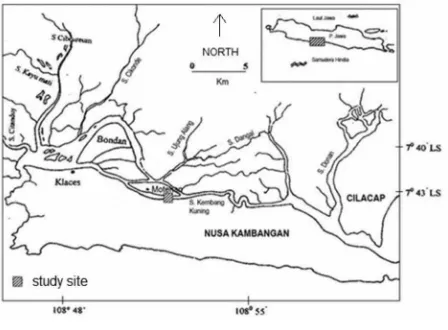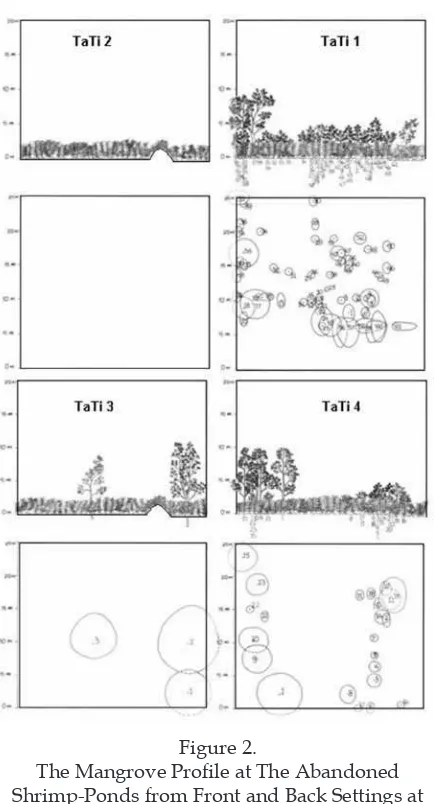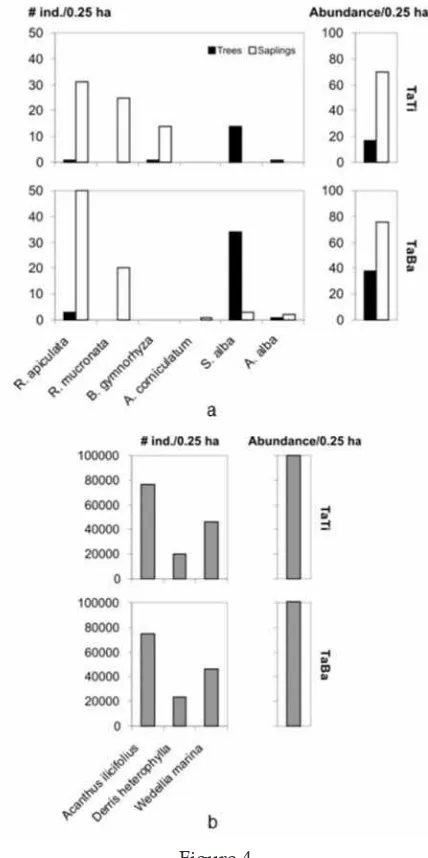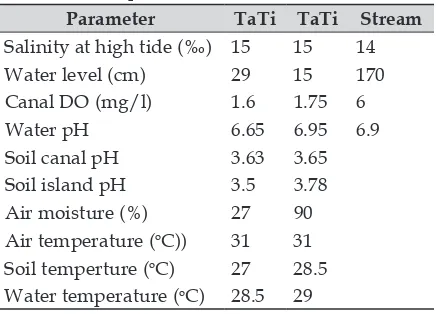COLONIZATION OF MANGROVE FOREST AT ABANDONED
SHRIMP-POND OF SEGARA ANAKAN-CILACAP
Tjut Sugandawaty Djohan
Laboratory of Ecology and ConservationFaculty of Biology Universitas Gadjah Mada Email: tdjohan95@yahoo.com
ABSTRACT
During the 1996 to 1997, large areas of mangrove forest in the Segara Anakan were cleared and converted into intensive shrimp-ponds. After one to two years, these shrimp-ponds failed and were abandoned. These abandoned ponds created large gap areas and canopy gaps, which were colonized by mangrove shrub and liana. The Segara
Anakan mangrove also experienced heavy siltation, and there were tree cuttings from the remnant of the mangrove
trees. This research aimed to study the colonization of mangrove vegetation at the abandoned-shrimp pond.
Vegetation data were collected using rectangular plots of 25 m x 25 m with 4 replicates. The water qualities were
also studied. The results revealed that the mangrove forests were composed of two layers: canopy tree and
loor-vegetation. The gap areas triggered the pioneer species of mangrove shrubs and liana, Acanthus ilicifolius and
Derris heterophylla, to colonize and dominate 100% of the mangrove forest loor. The mangrove trees consisted of natural and planted tree species. The natural trees were Sonneratia alba, Avicennia alba, and saplings of Aegiceras
corniculatum, which varied between 56 – 136, 4, and 4 individuals per ha, respectively. The planted trees were Rhizophora apiculata, which amounted to 4 – 12 individuals per ha, at the island of the ponds. These trees and saplings were entangled by the liana mangrove, which disturbed their growth. The A. ilicifolius and D. heterophylla
prevented the mangrove tree propagules to grow, and they colonized and characterized those abandoned shrimp-ponds, which threatened the Segara Anakan mangrove ecosystem.
Keywords: Canopy gap, Mangrove tree, Acanthus, Derris
ABSTRAK
Pada tahun 19961997, hutan bakau di Segara Anakan dalam skala luas ditebang dan diubah fungsinya
adalah Rhizophora apiculata, 4-12 individu per-ha. Pohon tersebut dililit oleh liana bakau dan telah menganggu pertumbuhannya Acanthus ilicifolius
dan D. heterophylla mencegah propagule pohon bakau untuk tumbuh berkembang. Semak dan liana semak bakau mendominasi dan mencirikan hutan bakau rusak, dan telah mengancam keberlanjutan ekosistem hutan bakau Segara Anakan.
Kata Kunci: Gap kanopi, Pohon bakau, Acanthus, Derris
INTRODUCTION
The mangrove of Segara Anakan (SA) is the largest area of remnant mangrove in Java. During the 1996 to 1997 large areas of man-grove forests were cleared and converted to intensive shrimp-ponds at alarming scale. However these shrimp-ponds were failure and abandoned which left the large-gap ar-eas and threatened the mangrove ecosys-tem services (Djohan 2007; Djohan 2012). A healthy mangrove-forest was highly produc-tive ecosystem, which were dominant along many tropical and subtropical coastlines. Their productivities were very high, and provided ecosystem services for many spe-cies with ecological and economical values in mangrove ecosystem itself and sea scape isheries. This mangroveecosystem served as nursery grounds for economic values of larvae of shrimp, crabs and ishes. and eco-logical valuesorganism, such as iddler crabs (Odum 1971; Ronnback 1999; Ronnback and Primavera 2000; Nagelkerken et al. 2008; Barbier and Cox 2004).However at the SA mangrove ecosystem, these services were in questioned due to the loss of large amount of mangrove trees. SA cut the commercial values trees, Bruguiera spp. and Rhizophora spp. (Sunaryo 1982; Djo-han 2007). This caused the mangrove trees as sources of the propagules were rare.
More over at SA between the 1996 to 1997 large areas of mangrove forest were land clearing and reclaimed to extensive and intensive-shrimp ponds. This mangrove rec-lamation to the shrimp ponds was carried out by the outsiders and supported by the villagers of SA. The mangrove forest clear-ance caused the economic mangrove-tree propagules became not available. Since then, the people from other area also cut down the non-economic value trees such as Avicennia spp., and Sonneratia sp. (Djohan 2007). Big disturbance played crucial rule in various forest ecosystems. They represented major shaping forces in forest succession and spa-tio-temporal processes (Vogt et al. 2014).
man-tree cuttings, and climate change worsen the SA mangrove ecosystem. In the 2007, the salinities of the waters varied seasonally, be-tween hypo-saline during the rainy season, and hyper-saline in dry season. Thus at the SA estuary, the salinities did not response to the tide-period daily.
The shrimp productions were the prima-ry aquaculture activities, which were respon-sible for the loss of mangrove trees in many tropical countries. It happened also at the SA mangrove ecosystem. Moreover, the conver-sions of the mangroves forests by shrimp ponds were irreversible. Without careful eco-system restoration and manual replanting ef-forts, mangroves did not regenerate even in abandoned shrimp-ponds areas (Barbier and Cox 2004).
In the SA, the abandoned shrimp-pond created a large gap area, which triggered the colonization of pioneer mangrove loorspe-cies, A. ilicifolius, and D. heterophylla, which had r and K strategies. These species out com-peted to the mangrove tree seedling to grow (Djohan 2007). In the 2001 at SA, the rehabili-tations of mangrove tree species efforts were established at the island of the abandoned shrimp-ponds of this research area by SACDP, a government conservation project. The seed-ling of mangrove trees, R. apiculata, R. mucro -nata, and Bruguiera gymnorhiza, were planted at the abandoned shrimp-ponds with distance of 1 meter. The project only planted the seed-ling of the mangrove trees, but they did not take care of the planted seedlings to grow (Parmin of Desa Motean 2007: Pers. Comm.).
The large areas of abandoned shrimp-ponds immediately were colonized by
man-grove loor species, since the natural tree propagules were not available especially Rhizophora spp, and Bruguiera spp. Therefore in this abandoned shrimp-pond, the research addressed the questions: (1) How was the for-est proile? (2) What were kinds of the growth form and species present? (3) How were their densities, and which one was dominance? (4) How were the conditions of water qualities of the stream inlow, shrimp pond canal and island included salinity, dissolved oxygen (DO), pH, air temperature, and moisture. The purpose of this research was to study the colonization of mangrove vegetation at the abandoned shrimp-pond. This research was part of the long-term study in attempt to re-construct the abandoned shrimp-ponds with the mangrove trees as a model for the sus-tainable ecosystem.
Methods
Figure 1.
The Abandoned ShrimpPond Studied Area was at Fringing Mangrove of Nusa Kambangan, and next
to Motean village.
Data Collections
On each pond of TaTi and TaBa, the vegetation data were collected using quad-rate plot of 25 m x 25 m with 4 replicates. The parameter measures
were: the vertical forest-layers; growth forms of the vegetation; number of species; number of individual of each species, tree height, and tree canopy coverage. The for-est proile was constructed using Oldeman
MicroWinkler Methods, temperature, and moisture with 5 replicates.
Data Analyses
Figure 2.
The Mangrove Proile at The Abandoned ShrimpPonds from Front and Back Settings at
TaTi.
Explanation: The projection of vegetation only for mangrove tree and sapling coverage. The TaTi 2 and TaTi 3 had levees, which was dominated by non-mangrove shrub species, Wedelia marina. The forest proiles were composed of two layers, except at the TaTi 1. The irst layer was consisted of mangrove tree and sapling canopies. The second layer was dominated by loor mangrove vegetation. The forest loor vegetation was covered by 100% of A. ilicifolius and D. heterophylla. The mangrove forest trees were dominated by naturally growth of Sonneratia alba.
Shrimp-ponds of TaTi and TaBa at all quadrate plots (Figure 23). But, the TaTi2 only had one layer of forest loorvegetation. The abandoned shrimp-ponds created large gap-areas, and were considered as big disturbance to the SA mangrove ecosystem, due to their large number of abandoned shrimp-ponds. These large gap-areas had triggered the pioneer
spe-cies of mangrove shrubs and liana, Acanthus ilicifolius and Derris heterophylla, developed and colonized almost 100% of the mangrove forest loor at both the abandoned shrimp ponds. Both of these species were out competed to the seedlings of mangrove trees. Therefore, the seedlings of the mangrove tree were not found at those abandoned shrimpponds (Figure 4ab).
Growth form and Abundance of
Species
The forest at the abandoned ponds, were composed only by 4 growth forms. These growth forms were mangrove trees, saplings, shrubs and liana. However, the plot of TaTi 2, only had 2 growth forms of shrubs and liana (Figure 4). At the forest proiles with two lay-ers, the irst layer was composed by mangrove trees and saplings. The second layers were dominated by mangrove shrubs and mangrove liana (Figure 24). The mangrove trees were rare and consisted of natural and planted tree spe-cies, but the shrubs and liana at the forest loor grew naturally. The natural-tree species were composed of Sonneratia alba, and Avicennia alba. The planted tree was Rhizophora apiculata and Bruguiera gymnorhiza. The number individual of Rhizophora were 4 and 12 trees per ha at TaTi and TaBa inconsecutively, which were 5.88 and 7.89% of the total trees in the ponds.
The Tree-Sapling Canopy and Tree
Height
man-grove tree-sapling. The manman-grove tree heights varied between shrimp pond and tree species: 5.0 to 9.0 meter (Figure 2; Figure 3; Figure 5b). The saplings heights were 1.5 to 4.0 meter. The variation of tree height responded to the soil and water conditions.
Figure 3.
The Mangrove Proile at The Abandoned ShrimpPonds from Front and Back Site Settings
at TaBa.
Explanation: The projection of forest layers were only for tree and sapling coverage. The TaBa 3 and 4 had levees, which was dominated by non-mangrove species, Wedelia marina. The projection of forest layers were only for tree and sapling coverage. The proiles were composed of
the planted seedling. The conservation project did not take care of the planted mangrove-seed-lings to grow and develop; they just left these planted seedlings to the nature. These unfortu-nate planted-seedlings were loss competition to the mangrove shrubs and liana, A. ilicifolius and D. heterophylla. As mentioned before, the total of tree canopy-coverage at TaTi and TaBa between 1040%. Thus the abandoned shrimp ponds created large gap areas, which caused big disturbance and threatened to the sustain-able of mangrove ecosystem at SA. Rejmanek (1984) reported that a simulation of a single big disturbance of spruce forest in Krknose Moun-tains of Czechoslovakia led to loss of twothird of three Growth forms, grasses and shrubs, within 40 years, and the spruce trees dominat-ed the area. Therefore the big disturbance at the mangrove forest ecosystem had threatened the biodiversity of mangrove species at the SA.
It is interesting to note that abandoned shrimp-pond at TaBa had more mangrove trees than TaTi, 152 individual per ha compared to 68 trees per ha (Fig 34; Figure 4a). Even though the number of the mangrove trees was abundant, but both the abandoned ponds did not have the seedling trees. As mentioned before, the seedling trees cannot develop in the abandoned shrimp-pond due to the colonization of the forest loor with the mangrove shrub and liana of A. ilicifolius and D. heterophylla. Their present disturbed the mangrove tree-propagules to develop. Therefore in the SA, without careful ecosystem rehabilitation efforts of the abandoned shrimp-ponds, mangroves trees would not regenerate in mangrove gap area and even in the abandoned shrimp-ponds.
the source of the tree propagules; (2) The out-sider people of the SA also cut the non-eco-nomic value of the mangrove tree, Avicennia, and Sonneratia ; (3) The seedling mangrove-trees loss competition to the mangrove shrubs and liana, Acanthus ilicifolius and Derris.
Figure 4.
a. Densities of each Species the Mangrove Tree and its Abundance at TaTi and TaBa per 0.25 ha;
b. Density Mangrove Floor Vegetation, and there
were no Chance ofthe Mangrove Tree-seedlings to Developed because They Lost Competition to the Mangrove Shrubs and Liana
heterophylla.
Explanation: Both of these species had r and K strategies, which mean they reproduce and grow quickly through seed, and also they have long live. In contrast, the mangrove tree-seedlings grow slowly,
even though they have long-live, but they loss competition to the mangrove shrubs, A. ilicifolius, especially for the light. More over the mangrove trees and saplings were colonized by the mangrove liana, D. heterophylla. This liana grew and entangled the tree trunks, which was
disturbed the mangrove tree to grow.
The species of sapling were composed of R. apiculata, R. mucronata, Avicennia alba, and Aegiceras corniculatum. With the exception to the sapling of A. alba and A. corniculatum which grew naturally. All the saplings of the mangrove trees were planted. Even though the conservation project had planted the mangrove-tree seedling
a. b.
Figure 5
a. The Tree Canopy-Coverage at all Quadrate Plots of Both the Abandoned Shrimp-Ponds of
the Abandoned Shrimp-Ponds, TaTi and TaBa with distance of 1 m x 1 m, but this reforestation
project was unsuccessful.
Explanation: Thus the mangrove tree and saplings were the survival of the project plantation, and they grew entangled with the mangrove liana, D. heterophylla, which was disturbed their growth.
The abundance of Rhizopora saplings at TaTi and TaBa were 224 and 280 individual per 1 ha, which were consisted of 80% and 92% of the total saplings inconsecutively. The heights of saplings varied 34 meter (Figure 4a; Fig 5). But the saplings of A. corniculatum were found only at TaBa, 4 individual per ha, and they grew naturally. In contrast, the saplings of Rhizophora mucronata were only found at TaTi. The trees and saplings of Bru -guiera gymnorhiza were only found at TaTi. The survival saplings of the planted-tree seedling were about 25%. However these saplings were colonized by mangrove liana, D. heterophylla. This liana entangled the sap-ling and trunks and disturbed their metabol-ic activities, such as photosynthesis. There-fore the future of these planted saplings were also threatened the future mangrove trees of Segara Anakan ecosystem.
As mentioned before, both the trees and sapling of R. apiculata, R. mucronata, and B. gymnorhiza were planted. It is interesting to note that the seedling of mangrove trees were absent at both ponds. The absent of the seed-ling of mangrove trees due to the coloniza-tion 100 % of mangrove forestloor with the mangrove shrubs and mangrove liana which have species ecologically r and K strategies. The saplings of mangrove trees at both aban-doned ponds were considered higher than the mangrove trees. Naturally, the mangrove saplings were the future mangrove trees.
% of mangrove shrubs and liana. Thus, the future mangrove trees at the Segara Anakan ecosystem were questioned, and threatened.
Mangrove-Forest Floor
The second layer of forest at the aban-doned shrimp-ponds were dominated by mangrove shrubs and mangrove liana, A. ilicifolius and D. heterophylla. Beside that at the levees of the pond werecolonized by We -delia marina. The W. marina is a shrubs and was not a mangrove species. If the W. mari -ana was not considered, therefore the man-grove forest loor at TaTi will be dominated by 100% by mangrove shrub and liana, A. ilicifolius and D. heterophylla of 306,475 and 80,737 individual per ha, with 79% and 21% total coverage of both species. At TaBa those both species were colonized by 298,804 and 92,794 per ha with 76% and 24% of the to-tal coverage. Thus both abandoned shrimp-ponds were colonized by mangrove shrubs. If the W. marina was included which was not mangrove-shrub species, the coverage of the ponds was between 186,240 and 186,240 indi-vidual per ha.
the waters were inundated and not lowing, which created the anaerobic conditions, and caused the dissolved oxygen (DO) was very low, between 1.6 – 1.7 mg perliter compared to the stream inlow, 6 mg per liter (Tabel 1). The low concentration of DO was not good to the aquatic communities such as shrimp, ish, and crab larvae in the abandoned shrimp-ponds, which relected that waters in this abandoned ponds were not in good condi-tions. These bad conditions were due to the abundance of the mangrove shrubs, which disturbed the tide movements, which also caused the dispersal of the mangrove-tree propagules failed to teach the abandoned shrimp-ponds. The water levels during high tides were between 15 and 29 cm and the stream inlow was 170 cm. Shallow
Tabel 1. The Water Qualities at Both Abandoned ShrimpPonds and Stream Inlow
.
Parameter TaTi TaTi Stream
Salinity at high tide (‰) 15 15 14
Water level (cm) 29 15 170
Canal DO (mg/l) 1.6 1.75 6
Soil temperture (oC) 27 28.5 Water temperature (oC) 28.5 29
water in the canal were also due the sed-iment illed the canals. The pH was between 6.65 and 6.95, but the soil pH was very low between 3.5 and 3.8 and caused by the low DO. The water salinities during high tides forest: (1) Mangrove tree layer was occupied by the natural tree layer of Sonneratia alba,
and the planted tree species of sapling of Rhizophora apiculatawhichhad low survival rate; (2) Mangrove loor vegetation layer was dominated by 100% of mangrove shrub and liana: Acanthus ilicifolius, and Derris hetero -phylla, which were prevented the propagule and tree-seedlings of the mangrove species to grow and develop. The A. ilicifolius and D. heterophylla colonized and characterized the mangrove of Segara Anakan. The Large areas of the abandoned shrimp-ponds were responsible for the loss of the mangrove trees and threatened the sustainable of the Segara Anakan mangrove ecosystem.
Acknowledgements
I thanks to students M. A. Fathony, Ardyan Pramudya Kurniawan, Subekti Pri-hantono, Dwi Purbarini, and assistant Krisni Suhestiningsih S.Si, and technician bapak Suyono at Laboratory of Ecology and Con-servation Faculty of Biology UGM for their help in collecting, tabulating data. I also thanks to bapak Parmin, bapak Dedi, bapak Trisno, bapak Sumarno, and Ibu Sutarjo of Motean Segara Anakan for their unending help in collecting data and accommodating this ield works. I appreciated the comments of the anonymous reviewers.
BIBLIOGRAPHY
Barbier EB and Cox M (2004) An economic analysis of shrimp farm expansion and mangrove conversion in Thai-land. Land Economics 80(3): 389407. Djohan TS (2007) Mangrove succession in
Segara Anakan, Cilacap. Berkala Ilmiah Biologi 6 (1): 53-62.
Djohan TS (2012) Distribution and abun-dance of mangrove vegetation in the disturbed ecosystem of Segara Anakan, Central Java. Jurnal Manusia dan Lingkungan 19(3): 294302.
HM, Sasekumar A and Somerield PJ (2008) The habitat function of mangroves for terrestrial and marine fauna: A review. J. Aqua. Bot. 89: 155– 185.
Napitupulu M and Ramu KLV (1982) Development of Segara Anakan area of Central Java, p. 6682. In E.C.F. Bird, A. Soegiarto, K. A. Soegiarto, and Rosengren (eds). Proceeding of workshop on resources management in the Cilacap region. The Indonesian Institute of Sciences and the United Nations University. Jakarta.
Odum EP (1971) Fundamentals of Ecology. 3th Edit. W. B, Sounders Co. Philadelphia.
Rejmanek M (1984) Perturbationdependent coexistence and species diversity in ecosystem.In Stochastic phenomena and chaotic behavior in complex systems.ed. P. Schuster. New York. Springger-Verlag, 220-230.
Ronnback P (1999) The ecological basis for economic value of seafood
production supported by mangrove ecosystems.Ecological Economic. 29: 235-252.
_________, and Primavera JH (2000) Illu-minating the need for ecological knowledge in economic valuation of mangrove under different mana-gement regimes – A critic. Ecological Economic 35(2): 135-141.
Sunaryo I (1982) A loristic study of mangrove forest in Segara Anakan. p. 132139. In E. C. F. Bird, A. Soegiarto, K. A. Soegiarto, and Rosengren (eds). Proceeding of workshop on resources management in the Cilacap region. The Indonesian Institute of Sciences and the United Nations University. Jakarta.




